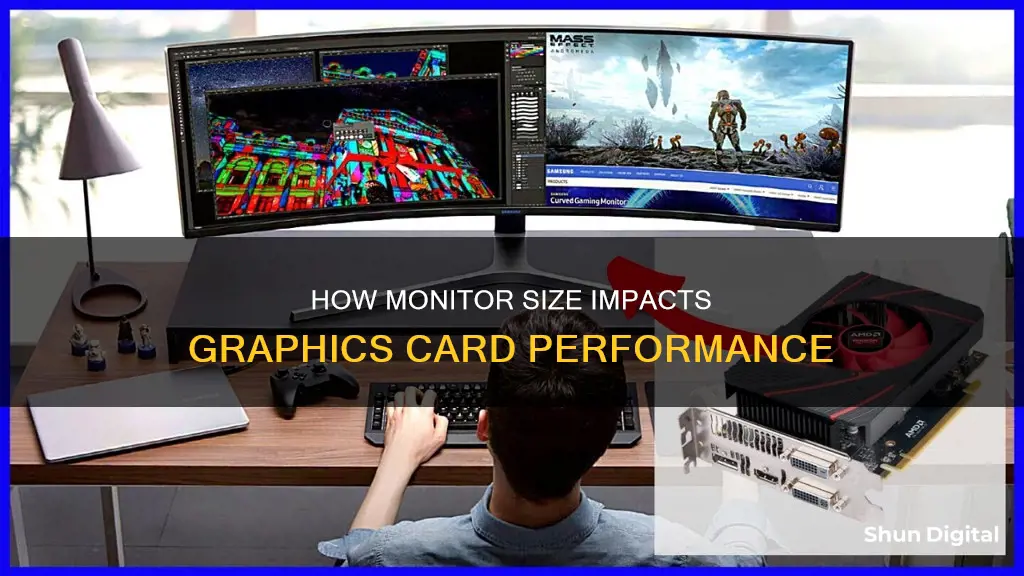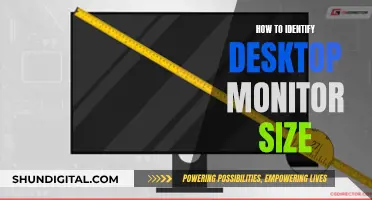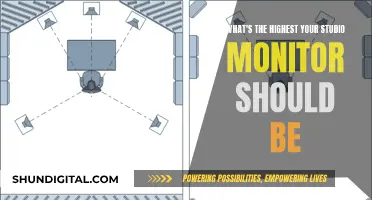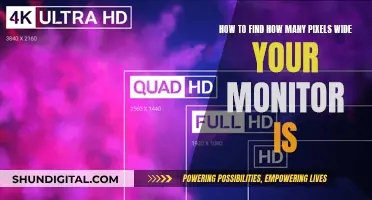
When it comes to PC gaming, the GPU (Graphics Processing Unit) and CPU (Central Processing Unit) are the stars of the show. Both are crucial for an immersive gaming experience, but the GPU takes centre stage as it renders images, animations and videos, creating the visual elements we see on screen. The CPU, on the other hand, is the brain of the computer, executing instructions, performing calculations and coordinating other components. The GPU's role is more demanding in games with high-fidelity graphics, where it maintains frame rates and handles lighting effects and detailed textures. The CPU, however, comes into its own in CPU-intensive games such as strategy, simulation and multiplayer games. While monitor size doesn't directly affect the performance of the graphics card, it does impact the player's experience. A larger screen can make targets easier to spot, but if it's too big, it can be a distraction, requiring more attention to peripheral vision. The resolution of the monitor is also important, as a higher resolution demands more from the GPU, which has to render more pixels. So, while monitor size doesn't directly influence the graphics card, it does play a role in how demanding a game is on the GPU.
| Characteristics | Values |
|---|---|
| Monitor size | A larger screen makes smaller things appear larger at the same resolution. |
| Resolution | The resolution of a monitor determines the amount of work the GPU needs to do to display an image on it. The smaller the resolution, the less work the GPU has to do. |
| Physical dimensions | A larger screen can affect gameplay, making targets easier to spot in shooting games, for example. However, a screen that is too large can be detrimental as it may take up too much of the player's range of vision. |
| Frame rate | A powerful GPU can maintain higher frame rates, contributing to a smoother, more immersive gaming experience. |
| Performance | A monitor with a higher resolution will require a more powerful graphics card to achieve the same performance. |
What You'll Learn
- A larger monitor can make targets easier to spot in games
- A monitor that takes up too much of your range of vision can be a problem for fast-paced games
- A monitor with delays may put you at a disadvantage in games where reaction speed is crucial
- A monitor with a higher resolution requires the GPU to do more work to display an image
- A monitor with a higher resolution and refresh rate demands more from your GPU

A larger monitor can make targets easier to spot in games
A larger monitor can indeed make targets easier to spot in games. This is because a larger screen makes smaller things appear larger at the same resolution. For example, if you're playing a sniper in a video game, you'll be able to spot your targets more easily on a 24" monitor than on a 15" laptop screen, even if the resolution is the same.
However, it's important to note that there is an optimal screen size for gaming, especially for first-person shooter (FPS) games. If a screen is too large, it may take up too much of your range of vision, requiring you to pay closer attention to your peripheral vision. This can be a disadvantage in fast-paced, reaction-based games.
Some gamers prefer smaller monitors, especially for competitive FPS games, as they feel it helps them focus on the middle of the screen, where their attention should be. Additionally, a smaller screen reduces the amount of area you need to concentrate on, allowing you to more effectively spot and shoot enemies.
The ideal screen size also depends on the type of game you're playing. For games that require constant scanning of the corners of the screen for information, a smaller screen size is preferable. On the other hand, for FPS games where the focus is mainly on the middle of the screen, a larger screen can provide a slight advantage by making targets appear larger.
Ultimately, the optimal screen size for gaming depends on individual preferences and the specific game being played. While a larger monitor can make targets easier to spot, it's important to find a balance to ensure that the screen size doesn't hinder your peripheral vision and reaction speed.
Monitoring Memory Usage: A Guide for SQL Server 2008
You may want to see also

A monitor that takes up too much of your range of vision can be a problem for fast-paced games
A monitor that takes up too much of your field of vision can be a problem for fast-paced games. While having a larger screen can make targets easier to spot, there is a limit to the usefulness of larger screens. If a screen takes up too much of your range of vision, you risk having parts of the screen that are functionally outside your focal point. This requires you to pay much closer attention to your peripheral vision than you might otherwise have to. This can lead to real problems in fast-paced, reaction-based games.
For example, imagine playing a first-person shooter (FPS) game on a large, ultra-wide monitor. While the larger screen size might allow you to spot enemies hiding in the corners of your screen more easily, it could also make it more difficult to react quickly to enemies appearing on the edges of your peripheral vision. In a fast-paced game where reaction time is crucial, this could put you at a disadvantage.
The ideal screen size for gaming depends on several factors, including the player's seating position, the resolution of the monitor, and the type of game being played. For example, a player sitting close to a high-resolution, large screen may find that their field of vision is overwhelmed, while a player sitting further back or using a lower resolution may not experience the same issue. Additionally, certain game genres may benefit more from a larger field of view, such as strategy or simulation games, where quick reactions are less critical.
It's worth noting that while screen size can impact the gaming experience, it does not directly affect the performance of the graphics card or the computer. The graphics card's performance is primarily determined by factors such as resolution, refresh rate, and the complexity of the game's graphics. However, by influencing the player's field of vision, screen size can indirectly affect their ability to react and respond to in-game events, particularly in fast-paced games.
Adjusting ASUS Monitor Brightness: A Simple Guide to Reducing Screen Glow
You may want to see also

A monitor with delays may put you at a disadvantage in games where reaction speed is crucial
A monitor with high delays can put you at a disadvantage in games where reaction speed is crucial. While most monitors have low delays, some don't. A monitor with delays puts you at a disadvantage in fast-paced games where reaction speed is crucial, such as FPS, fighting games, and beat games. The general recommendation is to use a monitor with a delay of 5ms or less. Televisions, which many people use for gaming, often have much higher delays. CRTs monitors, on the other hand, have extremely low response times, which is one reason they are still manufactured.
In addition to delays, the resolution and physical dimensions of a monitor can also impact gaming performance. The resolution of a monitor determines the workload on the GPU, as lower resolutions require rendering fewer pixels, resulting in fewer computations and less vRAM usage. This can be advantageous for laptops with integrated graphics, as they can achieve higher frame rates at lower resolutions.
Physical dimensions also play a role in gaming performance. A larger screen makes objects appear larger at the same resolution. For example, in a sniper game, targets would be easier to spot on a larger screen. However, an overly large screen can become a hindrance if it takes up too much of your field of vision, requiring you to pay closer attention to your peripheral vision, which can be challenging in fast-paced, reaction-based games.
Unlocking G-Sync on Your ASUS FreeSync Monitor
You may want to see also

A monitor with a higher resolution requires the GPU to do more work to display an image
A monitor's resolution has a direct impact on the workload of the GPU, or graphics card, which in turn affects the overall gaming performance. A higher resolution means more pixels on the screen, which requires the GPU to work harder and perform more computations. This is because the GPU has to render and animate each individual pixel, and a higher resolution results in millions more pixels to process.
For example, a GPU may not be able to play a game smoothly at 30fps and a resolution of 1080p. However, by lowering the resolution to 720p, the GPU can now render the game at 60fps without sacrificing maximum settings. This is because there are fewer pixels to render at the lower resolution, reducing the workload on the GPU.
The relationship between monitor resolution and GPU performance is also evident when comparing different generations of GPUs. Older generations may not provide any noticeable improvement over newer ones when both are paired with a monitor of a standard resolution, such as 1920x1080. However, when upgrading to a monitor with a higher resolution, like 2560x1440, the newer, high-end GPUs demonstrate a notable jump in performance, showcasing their ability to handle the increased pixel count.
While a monitor's size does not directly influence GPU performance, it can impact the gaming experience. A larger screen can make targets in a game easier to spot, as smaller objects will appear bigger at the same resolution when viewed on a larger monitor. However, if the monitor is too big, it can become a hindrance, as parts of the screen may fall outside the player's focal point, requiring more attention to peripheral vision.
Wall Mounting Your ASUS: A Step-by-Step Guide
You may want to see also

A monitor with a higher resolution and refresh rate demands more from your GPU
A monitor's resolution and refresh rate are two key factors that influence the performance demands on your GPU. The resolution refers to the number of pixels displayed on the screen, typically measured as the width and height of the display, such as 1920 x 1080 (1080p) or 3840 x 2160 (4K). The higher the resolution, the greater the density of pixels, resulting in sharper and more detailed images.
The impact of resolution on GPU performance is significant. A higher resolution means the GPU has to render more pixels, which translates to increased computational requirements and higher vRAM usage. Consequently, a GPU may struggle to maintain high frame rates at higher resolutions. For instance, a GPU capable of delivering 90 FPS at 1080p might only be able to manage 18 FPS when switched to 4K resolution. This is because the GPU has to process and render a significantly larger number of pixels in 4K compared to 1080p.
The refresh rate, measured in Hertz (Hz), determines how frequently the display updates with new images. A higher refresh rate results in smoother graphics and a more fluid visual experience. While the refresh rate is primarily associated with the monitor's specifications, it also depends on the capabilities of the GPU. To take advantage of higher refresh rates, such as 120Hz or 144Hz, a dedicated graphics card is necessary to support those rates and ensure smooth visuals.
The interplay between resolution and refresh rate becomes crucial when considering GPU performance. For example, a GPU that can handle 1080p resolution at 120 FPS may not be able to maintain the same frame rate at 4K resolution due to the increased number of pixels. Therefore, when upgrading to a monitor with a higher resolution or refresh rate, it is essential to ensure that your GPU is capable of handling the increased demands to avoid performance bottlenecks.
Monitoring Internet Usage: BigPond's Guide to Online Activity
You may want to see also
Frequently asked questions
Yes, monitor size does affect graphics card performance. A larger screen makes smaller things appear larger at the same resolution, making it easier to spot targets in games. However, if a screen is too big, it can take up too much of your range of vision, requiring you to pay closer attention to your peripheral vision, which can be a disadvantage in fast-paced games.
Yes, resolution impacts the performance of a graphics card. The resolution of a monitor determines the amount of work the graphics card needs to do to display an image. A smaller resolution means the graphics card has less work to do, resulting in fewer computations and lower VRAM usage.
While monitor size does not directly impact the performance of the graphics card, it can enhance the gaming experience. A larger monitor with the same resolution as a smaller one will provide a better viewing experience, making targets easier to spot.
No, a bigger monitor does not use more CPU/GPU power as long as the resolution remains the same. However, the image quality may degrade as the screen size increases.
The ideal setup for optimal gaming performance strikes a balance between GPU and CPU capabilities. It is important to avoid bottlenecks by ensuring the GPU and CPU are well-matched, future-proofing the system, and considering the versatility of the setup for other tasks like streaming or content creation.







